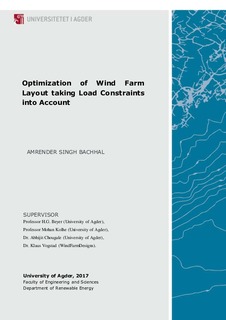Optimization of Wind Farm Layout taking Load Constraints into Account
Master thesis
Permanent lenke
http://hdl.handle.net/11250/2454262Utgivelsesdato
2017Metadata
Vis full innførselSamlinger
Sammendrag
Optimization of a wind farm layout is of utmost importance due its economical aspect. The primary
aim of optimizing layout is to increase the overall energy production. The higher energy production
creates more revenue from wind farm during its operational life time. Wind turbines situated within
wind farms are subjected to wake losses due to numbers of factors one of such factor is wind
disturbance from the wind turbines installed in front. Therefore, the wind turbines will produce
less output as compared to front wind turbines facing winds in free stream. Thus, to have an
economically feasible performance, it is necessary to optimize wind farm layout in terms of both
maximum energy and load constraints for life time of wind turbines. The turbines in the large wind
farm causing increased turbulence that increases the fatigue damage levels, and the increased loads
must be analysed. The thesis is devoted to the optimization of wind farm layout to maximize the
energy production, and verifying the significance of wake loss effects with respect to optimal
placement of wind turbines within wind farm. Thesis is divided into two followings parts:
In the first part, in the WFDs approach, the WindSim software for CFD simulations is used to
calculate flow fields at various heights over the planned layout to set number of turbines as per
IEC 61400-1 standard. Then, the resulting layout from WindSim is fed into the Wind Assessment
Tool (WAT) to check if the chosen position of turbines verifies the IEC compliance criteria for
effective turbulence. Next, the Park layout is used as in Park Optimizer tool to verify the project
constraints, such as exclusion of areas where it is not possible to set up turbines, layout is optimized
by calculating the energy production, etc. The Park optimization is based on the following factors:
i) minimum distance between turbines, ii) to check the effective turbulence if it’s not violating IEC
criteria, and iii) minimizing wake deficits.
In the benchmarking of software tools, Wind Farm Designs (WFDs) optimization approach is used
to maximize the annual energy production (AEP) by optimizing the turbine positions and
comparing it with OpenWind (OW) software tool. OpenWind tool is used significantly for the
layout optimization. The difference between both WFDs and Openwind optimization results
compared based on gross and net annual energy production, and array efficiency from the park
layout. Based on the results, it was found that the WFDs estimated lower net energy and array
ii | P a g e
efficiency as compared to OpenWind optimizer for the entire wind farm layout, differs same for
both -1 %. However, the gross energy is estimated almost similar by both the tools, but WFDs
optimizer estimated slightly lower.
In the second part of thesis, an analytical approach is used to check the sensitivity of wake losses
at distances that are IEC compliant for simple cases between two turbines. Jensen wake model is
used for the wake loss analysis due its high degree of accuracy. Frandsen model is used to satisfy
effective turbulence criteria. The energy production of downwind turbines decreases from 2 to
20% due to the lower wind speeds as they are located behind upwind turbines, resulting in
decreasing the wind farm overall energy production. Higher wake loss also increases the effective
turbulence that leads to reduction in overall energy production within wind farm.
Beskrivelse
Master's thesis Renewable Energy ENE500 - University of Agder 2017

